It’s great from time to time, to look back on where a racing class originated from. A bit of historic perspective instills a sense of pride when heritage enters into the view upon looking back on one’s roots. Pro Dragster, (P/D) is just such a class with a deep-rooted, rich history worthy of a good look back to its origins.
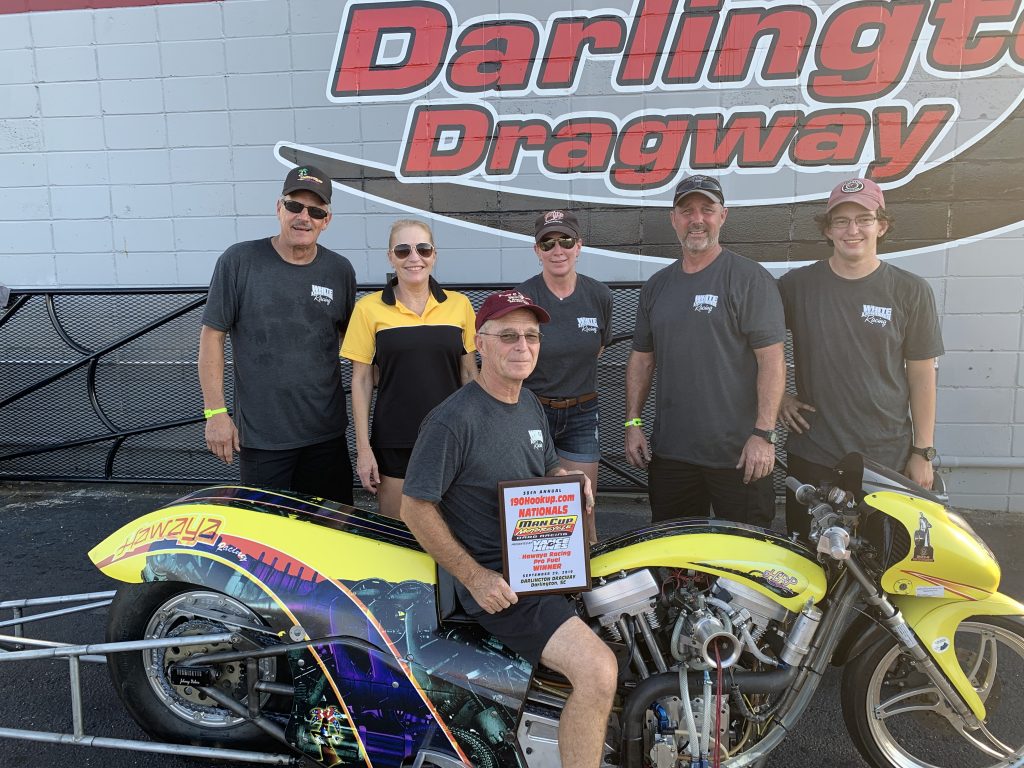
Pro Dragster motorcycle drag racing really begins with its fuel bike roots firmly seeded in the mid to late 1960’s. While it is a mater of recorded history that fuel bike racing began when drag racing itself began in the early 1950’s, the shape and dimension of Top Fuel motorcycles as a mater of class racing began in earnest around 1967 and progressed markedly with the advent of the A.M.D.R.A. sanction. Today’s P/D bikes are direct descendants of the early T/F bikes. Their relationship is inescapably intertwined throughout motorcycle drag racing history. Their modern era metamorphosis takes shape beginning in 1966.
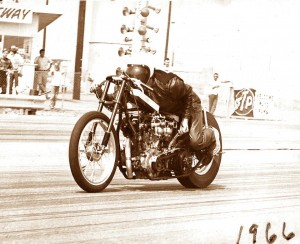
On the east coast, during the mid 1960’s, some of the first early “all bike” meets came together under the leadership of Roy Strawn and his fellow hard working associates that in time came to form the A.M.D.R.A. or American Motorcycle Drag Racing Association in 1970. Within AMDRA’s rule structures were fuel bike classes based on engine cubic inch displacement, not unlike the way motorcycle drag bike class racing began in the 1950’s.
Dedicated Harley fuel racers like Joe Smith, Leo Payne, and Dick Prime, were in the forefront fighting the good fight for Harley Davidson against the import bikes in the mid to late 1960’s. These three men and many others were all quite active in the fuel wars fought by Harley racers against the import bikes of the day; Triumph, BSA, Norton, and the powerful Vincent. Before “The Land of the Rising Sun” forever changed motorcycle racing, the British Invasion was the primary competition in early fuel bike racing.
Now when the nitro wars broke out between the Harley Davidson powered drag bikes and the import powered machines in the 1960’s, it’s important to note in this time frame the configuration of the basic fuel bikes the racers were bringing to the drag strips. Most all of the bikes venturing into fuel racing in the mid to late 1960’s were single engine, carbureted bikes with a modified frame for high speed stability, a lightweight frontend holding a skinny front tire, and a rear wheel that was either lightweight with spokes or a converted car wheel clutching a small bald car tire. In 1966, some drag bikes had motorcycle rear tires, others were off an automobile with either four or five inches across the tread face area. The basic concept of the mid 1960’s fuel drag bike is very important here: single engine, carbureted, small rear tire combination and no wheelie bars. Wheelie bars were not in use by drag bikes when LBJ was in the White House.
What was in use in ever increasing amounts in this time period was CH3NO2 as the primary fuel – good old nitromethane. But harnessing it was dark arts stuff from the start.
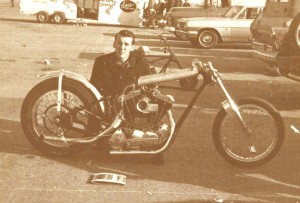
Because nitromethane is highly dangerous to interrupt while it’s making power, racers quickly learned to launch their bikes in high gear only and as the skinny rear wheel/tire combination broke traction and spun wildly, the throttle jockeys had to learn to feather the throttle and clutch a bit to control tire spin and await the hook-up of the rear tire. Once this was achieved, the pilot had to be mindful of the front end going airborne when it did. Driving these bikes was a handful from the launch to finish line. Excitement has always been and will always be the forte of Top Fuel bike racing.
In 1970, when the A.M.D.R.A. sanction came into full existence, it designated the larger cubic inch displacement bikes as Top Fuel motorcycles and the smaller displacement bikes fell into other classes like Jr. Fuel or Super Eliminator. The single engine, carbureted, high gear bikes started things off in fuel racing, but they were pushed aside during the 1970’s era of motorcycle drag racing.
Top Fuel motorcycle began as a single engine class initially, but by 1970 when the double engine bikes started taking over, the single engine, high-gear bikes started taking a distant backseat to the doubles. However, in the mid 1970’s, the single engine bikes with supercharging began appearing with constant flow fuel injection and soon the doubles were headed for extinction. Top racers always looking for that horsepower edge abandoned their double engine bikes and pushed on to bigger faster supercharged fuel bikes with single engines and fuel injection.
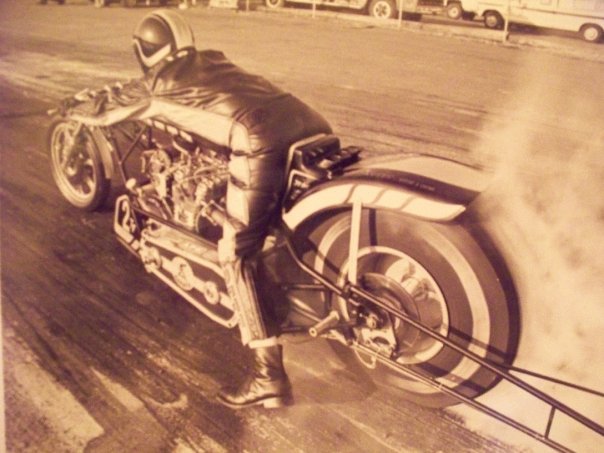
The simple high gear singles were phased out by drag racing’s power evolution before 1976. Then, the evolution of the sport itself brought the single engine, high-gear, fuel bikes back.
It started with the collapse of the primary single most important motorcycle drag racing sanction. The A.M.D.R.A., the only coast-to-coast “all bike” sanction, folded at the end of a disastrous 1976 season. The already under-funded sanction suffered 13 rain infused events in a 26 race season that year and that was it for the A.M.D.R.A. In the brief vacuum that followed, two very important sanctions quickly popped up: The I.D.B.A. or International Drag Bike Association and also DRAGBIKE!
The I.D.B.A. opened up it’s doors to racers beginning in the south eastern portion of the United States in 1977. DRAGBIKE! began it’s operations from the northeast at the same time. Because of their regional locations and their relativity to where the preponderance of drag bikes were located, DRAGBIKE! took hold as a viable sanction quickly.
In the early 1970’s, an entrepreneur with a journalistic background from upstate New York named Thomas E Loughlin Jr. had a small but strong news tabloid-type magazine that he covered motorcycle drag racing with known simply by it’s title “DRAGBIKE!” While Thomas would cover any drag race he happened to, his affinity and appreciation for A.M.D.R.A. was solid from the time A.M.D.R.A. became an official full-fledged sanction officially recognized by the NHRA in 1970. When A.M.D.R.A. closed operations in 1976, Thomas being the entrepreneur he is, leaped at the chance to begin his own sanction quickly adopting the name of his own publication DRAGBIKE! as his new venture.
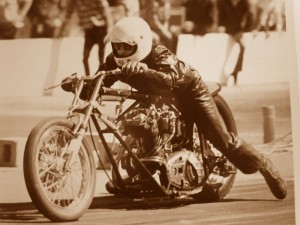
Much like Wally Parks who once played an integral role in founding the NHRA, while he was at the time, the editor of Hot Rod Magazine, and he then became the head of the NHRA, Thomas Loughlin Jr., at the time was the publisher for DRAGBIKE! and so named his drag racing sanction as it’s leader. Thomas had a tiger by the tail when he did this and he needed quality staff to rely upon.
One of the earliest members Thomas hired to his employ was a racer with a penchant for details and fair play; Mr. Jim Milsted. Jim was a New Jersey motorcycle drag racer who called the Atco drag strip his home, and indeed Atco became the cradle of organized motorcycle drag racing from the 1960’s era forward.
And it was Jim Milsted, a native of New Jersey that created the class today known as Pro Dragster in the form we all now know it in. Here’s how it happened according to the men who shaped today’s class we all know as P/D.
What follows here, for the most part, are the words of Jim Milsted, who in 1977, became the first full time national “Tech Director” for the DRAGBIKE! sanction while he was working for Thomas Loughlin Jr. the founder and creator of DRAGBIKE!. Mr. Milsted was kind enough to put his thoughts to words we can all share as we read how and why the class of Pro Dragster came into existence.
Milsted said, “Atco Dragway, in NJ, opened in 1960, not far from where I lived. I started going there almost every week in 1961. In 1965 when I turned 17, I started racing cars and in 1968, I began working as a foreign car mechanic. The dealership also sold Honda motorcycles. In 1966, I got my first bike, a 1965, BSA Hornet. By 1968 I had a Honda 305 Scrambler. The Honda mechanic and parts salesmen, Don Leady and Bill Taggart, convinced me to take my bike drag racing at Atco. Well I won my 1st time out! So I ran a couple more races and by October, I became the Atco, U.S. Nationals motorcycle class champion in 1968. That was it, I was hooked!
For the next couple of years, I learned about drag bikes and began traveling to various races around the country. As a racer, I began moving up in the classes each year, going quicker and faster. As I recall, around 1973, I went down to Sonny Routt’s shop in Maryland to order some big bore sleeves for my Honda dragster. While I was there, I ran into a Top Fuel Harley racer named George Sumner. He told me he had a Harley Davidson drag bike for sale. So I took the info and said I would try to sell it for him. About three weeks later I called to see if he still had it; he said yes. I said I’ll take it.
So I drove down to Falls Church Va. and brought home what would be my very own Harley Davidson powered fuel bike.
Man this was it, suddenly I was part of the big show, now fans would run to see me race! Boy did I have a lot to learn, this was my first Harley and I didn’t know squat about tuning a Harley for nitro. What I needed to know could not be found in some shop manual. But racers like Al Charlier, Mike Fedyk, Guy Leaming, Marv Jorgenson, Dick Prime and several others were very helpful to this newbie.
After 3 yrs. of running the HD, from 1973-1976, and going from Top Gas to Top Fuel, I realized I was on a sinking ship with my single engine bike. The Harley double-engine powered Top Fuel bikes were the new hot thing and the Jap bikes were getting their bugs worked out but were four-cylinder machines. I needed a new bike, more money and some machine shop equipment if I was going to stay in this race with the big dogs. So I decided to sell all of my race bikes for equipment to build bigger and better bikes with.
Then, suddenly it seemed like all drag bike racing would stop when at the end of 1976, the A.M.D.R.A. went out of business and the whole world changed for me.
This is when a man I knew from up-state New York, Tom Loughlin Jr. the editor and publisher of DRAGBIKE! magazine, then decided to start a motorcycle drag racing sanction and create a whole new racing organization he called DRAGBIKE! Tom called and asked me to be his National Tech Director. Since I was no longer racing, I said yes. I had done a little bit of Tech before for A.M.D.R.A. and at my home track ATCO, NJ, so this was not totally new job for me.
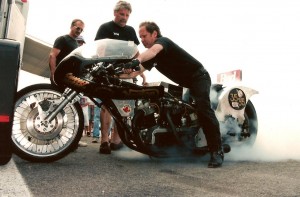
Author’s Note: Beginning in 1977, as the new DRGABIKE! sanction began operations with their new Tech Director, Jim Milsted, something came to Jim’s eye over the next two seasons about his old Top Fuel bike class that disturbed him; their ranks were steadily thinning in numbers. Jim recalls what happened like this:
What I was noticing was a lot of old Top Fuel and Top Gas Harley racers were no longer showing up to the races anymore. They were tired of getting beaten by the double-engine bikes and the Jap invasion. The double engine British bikes of Boris Murray, T.C. Christenson and Sonny Routt, were still holding their own, but they were starting to drop back too.
I first started chewing on Tom’s ear about this during our inaugural 1977 season. I said “We need to come up with a class to keep all of these 125” to 150 C.I.D., Harley Davidson singles coming out.” I even wrote a story for DRAGBIKE! magazine naming about 125 Harley Davidson racers that I knew of or had heard about, that had bikes that were no longer racing. So I suggested to Tom “Lets make a class for these bikes that already exist.” Now at the same time the class of “Funny Bike” (F/B) was just getting started and it seemed like the wave of the future, but I wasn’t about to let the past slip away. I knew we really needed to do something and here’s how it all came together.
During the 1978 season I went to the NHRA – NMRA race in Beech Bend. KY. Along with me on that trip was ATCO Dragway owner Jack Musilli and Tom Loughlin. That race turned into a promoter’s nightmare. But I did learn two things at that race, the only time the fans cheered was when a chic flashed her boobs or when a Harley went down the race track.
I suddenly remembered, at our first DRAGBIKE! race, which was held in Las Vegas, a racer named Squeeks O’Connor, came down with a nitromethane injected Kawasaki from Fairbanks, Alaska. He raced one round against good old Bonnie Truett on his Harley Davidson powered single engine drag bike. Well Squeeks was running about a full second quicker then Bonnie before they even lined up on the starting line. So when they left the line together, Bonnie’s rear tire went up in smoke and he smoked it almost the whole 1/4 mile.
Their race wasn’t even close, but the whole crowd went absolutely nuts! All you could hear people saying was; “If that Harley’s tire had hooked up, he would have kicked that Jap bike’s ass!” As racers, we all knew in the real world that would never have happened but the crowd impact was inescapable.
After the races I had a long talk with Loughlin. I said “We’ve got to do something. The only time the crowd cheers is when a girl flashes her boobs, or a Harley-Davidson goes down the race track.” We were trying to keep this a clean family sport and improve our motorcycling image, so the first option was out. Second option was to come up with a class and rules for the crowd pleasing Harley Davidson fans. So for the 1979 season I came up with a simple set of rules. PRO DRAGSTER , P/D ( or pushrod dragster as I called it ) that would get some of the old bikes and racers back out on the track. It wasn’t easy at first and the payout wasn’t that great. but I told the guys to stick it out and it would get better.
What followed was, during the late 1978 season, Jim Milsted sat down and wrote a detailed rule book for the coming 1979 season with the blessings of DRAGBIKE! sanction head Thomas Loughlin Jr. On page 37 of the “The Racer’s Bible – 79” Volume 3 No.4, for the first time appeared the words defining a new, but old rooted class: Pro Dragster Eliminator.
The opening statement reads, “This is a new eliminator for 1979, it is comprised of pushrod-type dragsters formerly competing in Top Fuel and Junior Fuel. It will be run on a trial basis for one year, this will be heads-up, no handicap-start racing.
The basic rules for the class in the first year of P/D were:
Designation: P/D preceded by the rider’s number
Engine Restrictions: Single engine, pushrod type
No: Supercharging, Turbocharging or fuel injection.
Unlimited engine displacement allowed
Any transmission allowed
Any clutch allowed
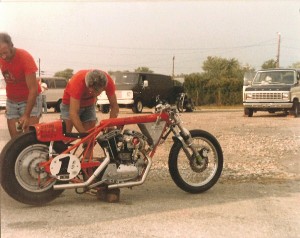
6” wide maximum tire tread allowed
No minimum or maximum weight required
These were the basics that started the class when it was born starting with the 1979 season of the DRAGBIKE! sanction. There were over two dozen races slated for the 1979 season. When the smoke cleared, the winner for P/D for the first year was a man who would leave his mark on Top Fuel motorcycle drag racing for all time. He came from the dirt drags, from the hills of Virginia and in his first year of racing on black top: he showed em all how it’s done. He then spent the better part of the next twenty years showing all Harley-Davidson fuel racers what one engine in one Harley Davidson can do. His name; the winner of the first year of P/D – Mr. Jim McClure, of Virginia. He later came to be known as, “Da Judge,” the toughest drag racer ever to throw a leg over a Harley Davidson fuel bike.
The author would like to thank the following contributors to this story: Mary Lou Brewton, Red Roberts, Thomas Loughlin Jr., Jim Milsted, Chris Rasile, Joe Smith, Roy Strawn, Andrea Wright, Bobby Spina, Bonnie Truett, John Gregory, T.C. Christensen, Jody Gregory, and Gordon Kately. If I missed anyone please know it was not intentional, many people contributed to this story in the last month.
There are more videos on the Cycledrag Youtube channel (please subscribe here) and the Cycledrag Facebook page (Please like here) and more will be coming soon. Check back daily.
To take advantage of some amazing discounts at Brock’s Performance, click – http://brocksperformance.com?aff=12
USE cycledrag5 coupon code.


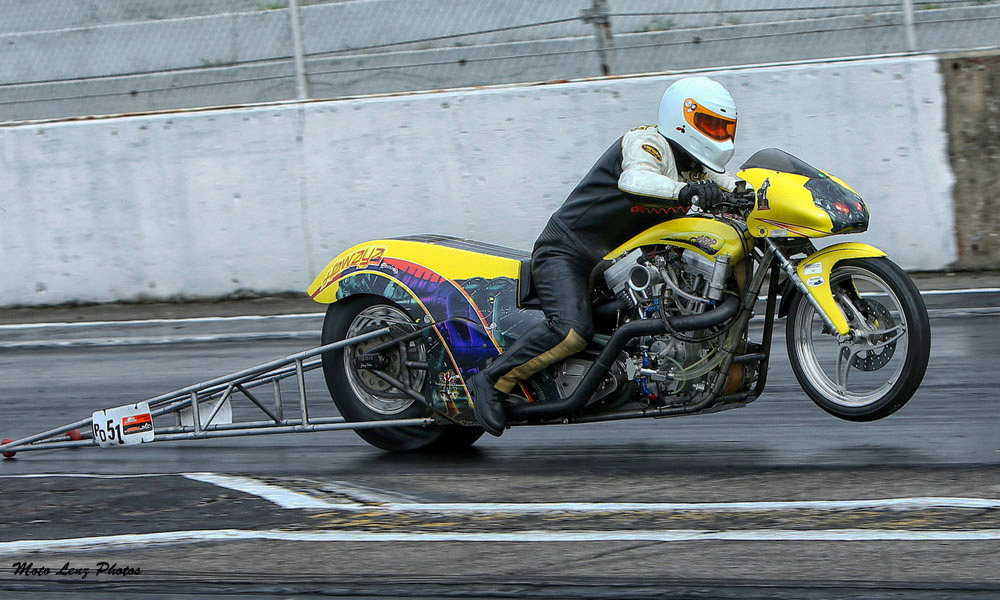













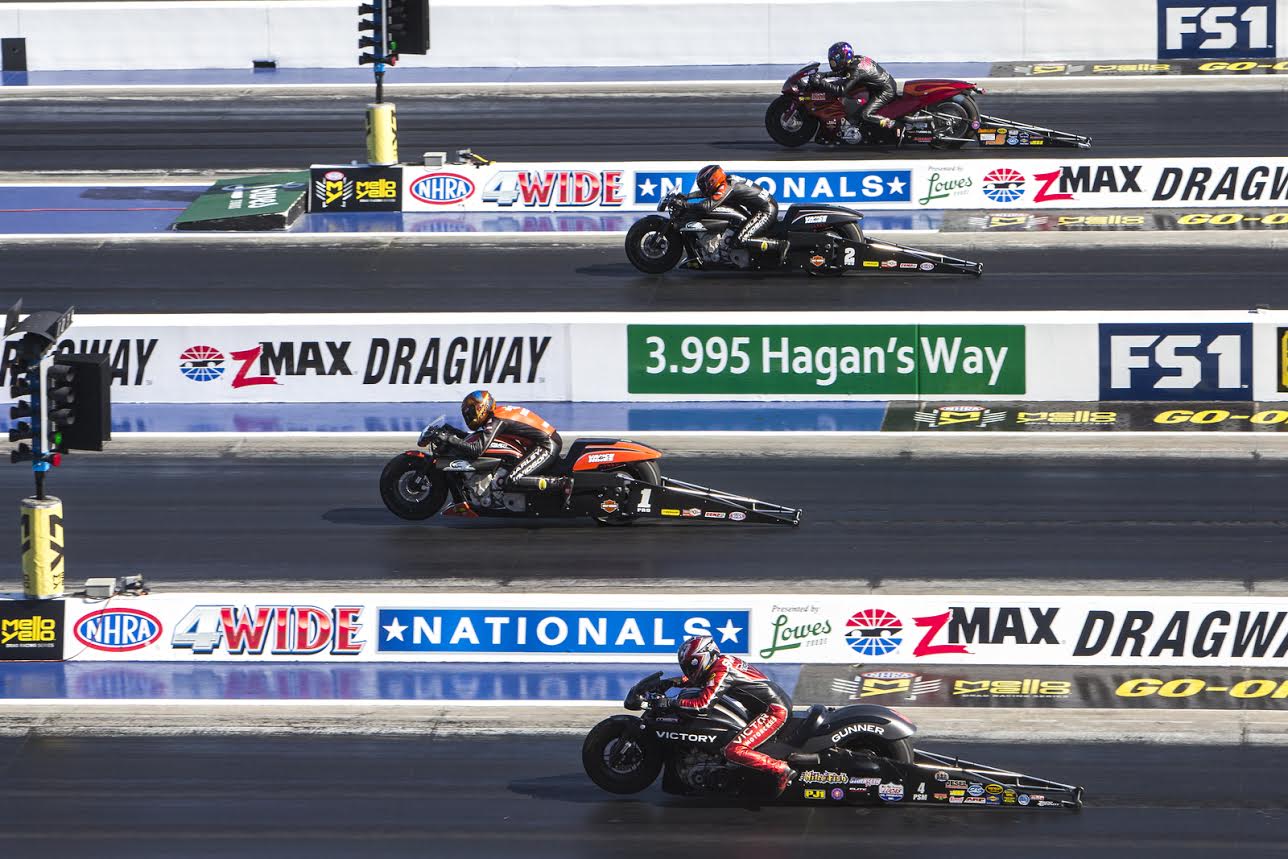



O man, that was awesome. I am so excited just to be able to read all this history and read about the men who influence my bike building and racing career I am trying my hardest to make happen. Thanks for this. I am truely amazed
Great read !!!!
Nice job Tom. I enjoyed this story, and of course the picture of me !!! 😉
Mr Kateley were you the tuner on Joe Smiths double ? I always see you in the pictures with him ? Also i remember once reading about the fuel carbs starving for fuel and did you not re design the float bowls making them waay larger to handle the input? I could have swore i remember reading this somewhere lon ago. Thanks
Jack Zist, I wasn’t the tuner, I just helped Joe at the track. He mixed fuel and I did the clutch. I also drove the pick up for tow starts. Pretty good team, and we had lots of great memories. I did build the bowls for the S&S carbs before Ontario in 1974. It was Joe’s first 180+ runs, and 8 flat et’s
For all my FACEBOOK FRIENDS that have no idea what I’m talking about when I mention what was a big part of my life, yesterday and today. MOTORCYCLE DRAG RACING. It’s what got me out of Paulsboro and traveling all over the country and meeting people I still call friends today. I might not have went in style, but I went. The good is it kept me broke so I couldn’t afford to do drugs or drink. Still don’t have those bad habits (:o). Of course I always wonder what might have been. And who doesn’t. There is one person who shared the good and bad with me and never gets the credit for all she put up with. Alice Albowitz Milsted. Mother of my children. My Pit Crew. My Secretary. My Co-Pilot on road trips. Chief cook and bottle washer. She never raced or won a trophy. But deserves all of the thanks for letting me live in a dream world for awhile. We even laughed about this the other day. Thanks also to Tom McCarthy, Photojournalist from Massachusetts for writting this little bit of history of the sport I love. Good story Tom. Thanks also Thomas E Loughlin Jr for the opportunity to leave my mark in the sport.
The words in this article are ” jetted properly”.
and this from a ” guy” old enough to honestly
say . I learned not to full power shift a nitro bike ,on the famed bike ” grandma” . Triumph single . When a 55 gallon drum of nitro cost $ 357.80.
hey guys don’t forget boris murray and a few others as well as my self.a thiumph lay down dragster,a gasser back then.1963,was called little egypt,running out of tenn.
thanks tom ,that’s a great read.thanks for the hard work!
thanks tom ,that was a great read,thanks for the hard work
Guys P/D is a great class in a great sport, see you all out there! Thank you all for your help.
Thank you
Thanks
Sad news to report. Bill Taggart, my old friend and fellow racer mentioned is this story passed away April 1, 2013. Thanks to Bill for his help getting me started. The largest picture posted at his funeral were of me , him and Don. R.I.P. BILL
More pictures of bob spina ( northern thunder )
You got it right, Thomas.
Pro Dragster and Pro Street were our inventions and they live on as dynamic testimony to the inventiveness of our group.Thanks for tipping your hat to all the other parties involved, too.
Tom Loughlin Jr.
Awesome to still be able to “google” my grandfather Richard “dickie” prime, and read some articles..
First time seeing this..brought back great memories of my old racing friends. Dick Prime & Sonny Raslawski & too many others to list…Thank you